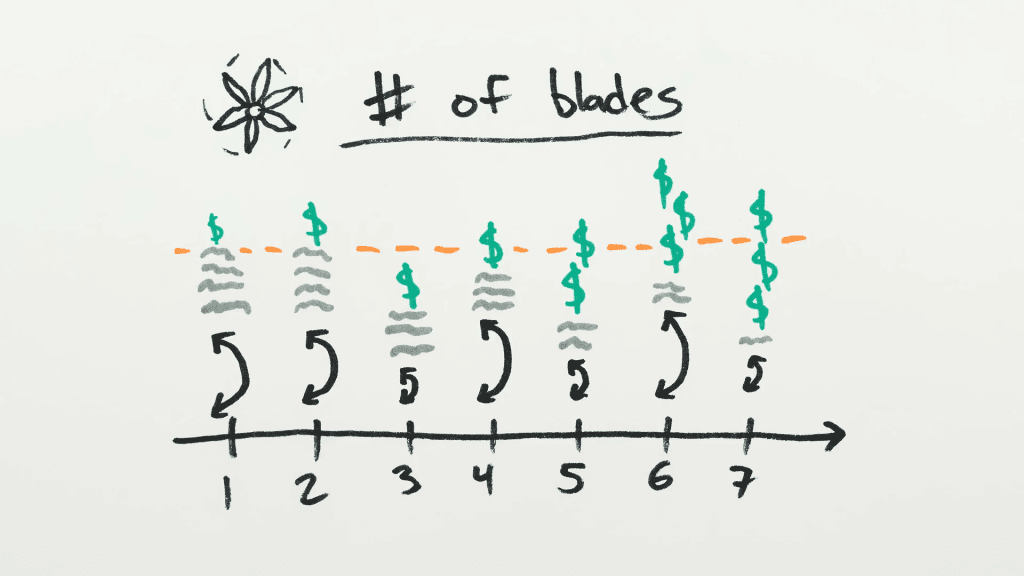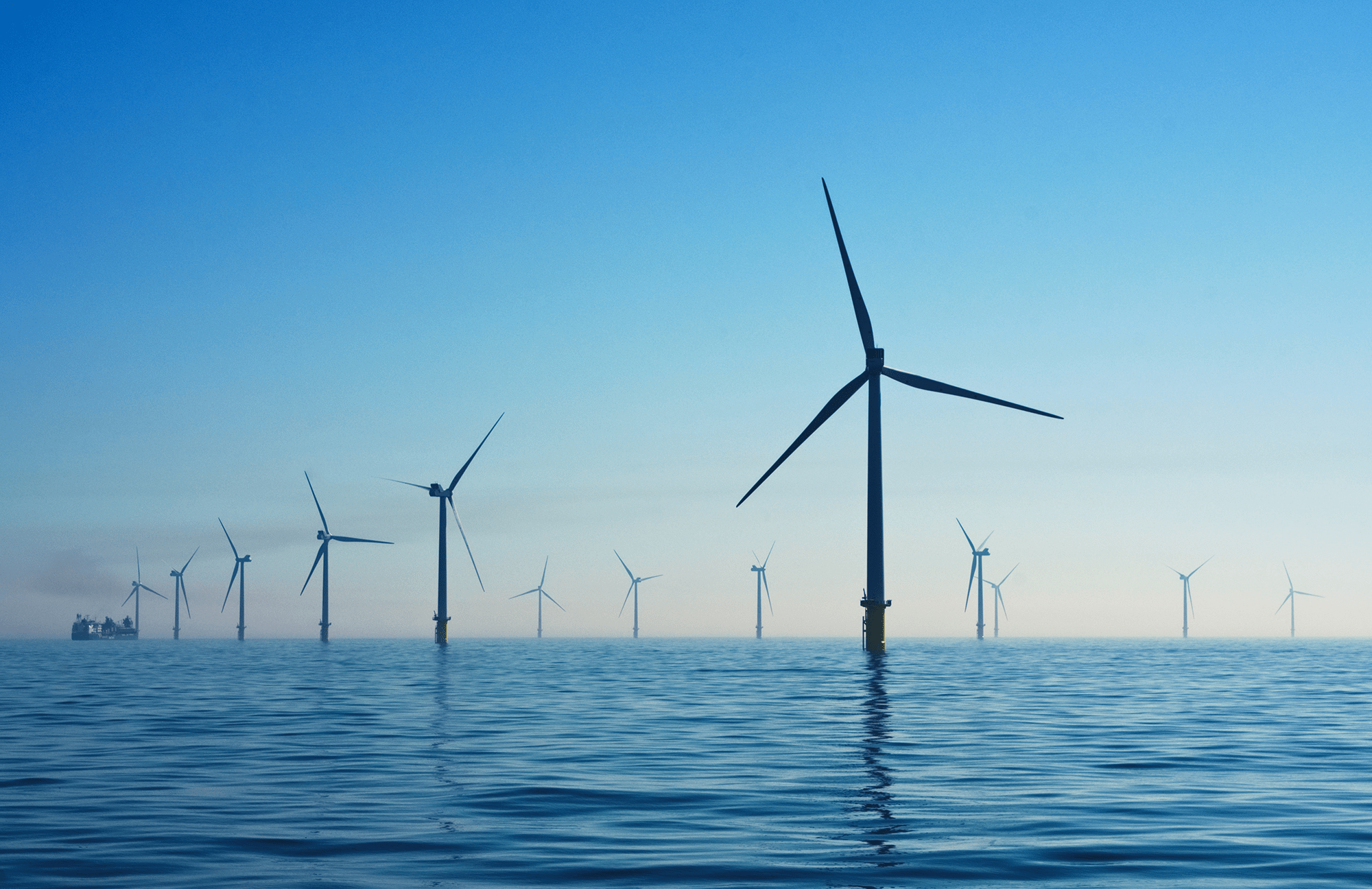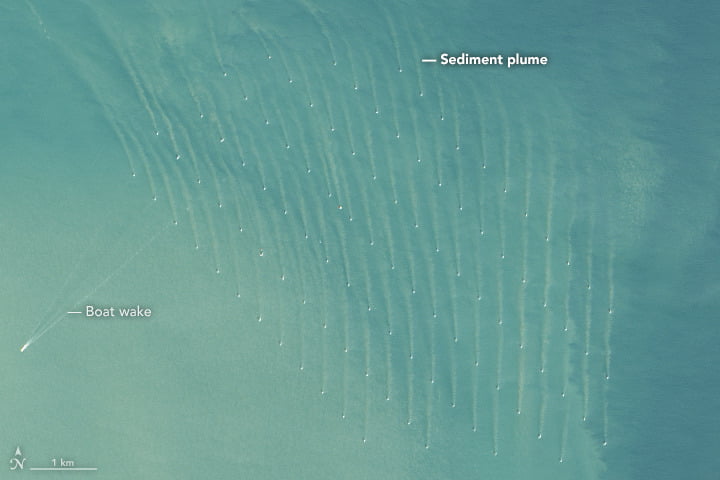Although wind turbines can have any number of blades, most that we see have three. The reasons for that are many, as explained in this Minute Physics video. In terms of physics, wind turbines with more blades produce more torque, but they pay for it with more drag. Engineering-wise, wind turbines with odd numbers of blades have less uneven forces on them, and, thus, cost less. And, finally, people just prefer the look and sound of 3-bladed wind turbines over other forms! (Video and image credit: Minute Physics)
Tag: wind turbine

Martian Wind Power
To support a crew on Mars, a landing site must offer resources like water and allow for sufficient power generation. Thus far, most analyses of this sort have focused on the possibilities of solar power, which is limited by day-and-night cycles and seasonal variations, and nuclear power, which carries some risk to the human crew. In a new report, researchers considered the possibilities of wind power on Mars.
Since Mars’s atmosphere is so much thinner than Earth’s, wind power has largely been overlooked as an energy source there. But researchers found that a commercially-rated wind turbine expected to produce 330 kW here on Earth could still output a respectable 10 kW on Mars. Since the target power needs for a crew are 24 kW, adding wind energy can boost a power system from providing 40% of needs from solar alone to 60-90% of the needed energy from combined solar and wind sources. A wind turbine is especially helpful in supplementing power needs at times when solar power wanes, like at night or during the Martian winter solstice. (Image credit: NASA; research credit: V. Hartwick et al.; via Physics World)

Optimizing Wind Farms Collectively
In a typical wind farm, each wind turbine aligns itself to the local wind direction. In an ideal world where every turbine was completely independent, this would maximize the power produced. But with changing wind directions and many turbines, it’s inevitable that upstream wind turbines will interfere with the flow their downstream neighbors see.
So, instead, a research team investigated how to optimize the collective output of a wind farm. Their strategy involved intentionally misaligning the upstream wind turbines to improve conditions for downstream turbines. They found that the loss in power generation by upstream turbines could be more than recovered by improved performance downstream.
After testing their models over many months in an actual wind farm, they reported that their methodology could, on average, increase overall energy output by about 1.2 percent. That may sound small, but the team estimates that if existing wind farms used the method, it would generate additional power equivalent to the needs of 3 million U.S. households. (Image credit: N. Doherty; research credit: M. Howland et al.; via Boston Globe; submitted by Larry S.)

Wind Turbine Efficiency
Wind turbines face a paradoxical challenge: they must extract the wind’s kinetic energy while still allowing the air to pass. In this Minute Physics video, Henry gives a crash course on wind turbine efficiency, based on the restrictions of conservation of mass and conservation of energy. When the two are combined, they show that an ideal wind turbine reduces the wind speed by 2/3rds to achieve ~59% efficiency.
Of course, actual wind turbines are far from ideal. They’re typically placed in staggered configurations in which upstream turbines can disrupt the flow seen by those downstream. And real wind turbines have to contend with dust, bugs, and other grime that builds up on the blades and disrupts air flow and their efficiency. But calculations like this one are still important for engineers seeking to make these machines as efficient as they can be. (Image and video credit: H. Reich/Minute Physics)

Wind Turbine Physics
Over the years, wind turbines have gotten tall with long, thin blades. This MinutePhysics video delves into the reasons for those changes. They’re all aimed at generating more wind power and doing so with greater efficiency.
I’ll add one caveat to the video, though, because you may wonder how modern wind turbines can be fast when they appear to rotate so slowly. That’s a trick of the reference frame. The power a turbine blade generates depends on the flow speed over it, and the relative air speed is greatest near the tip of the turbine blades.
Think of the circle the blade tip traces. For a given rotation rate – say once revolution a minute – the blade tip has a much larger distance to travel than the blade’s base does. Divide that large distance by the rotation time and you get a large velocity. So even though the wind turbine appears to be rotating slowly, the flow the blade sees is quite fast. And the longer the wind turbine’s blades, the larger this effect. (Image and video credit: H. Reich/MinutePhysics)

Vertical Axis Wind Turbines
Most people are familiar with the propeller-like shape of conventional wind turbines. These turbines can be more than 100m tall and can generate several megawatts apiece, but placing them in arrays requires a lot of open space because flow downstream of one turbine will interfere with the efficiency of the next. Vertical axis wind turbines (VAWT), like those shown in the photo above, are smaller and produce a fraction of the power of their larger horizontal-axis counterparts, but VAWTs can be placed much closer together. In fact, putting them in closely spaced arrays can actually increase their output through flow synergies. Researchers hope that eventually VAWT arrays will be able to produce significantly more power per land area than conventional wind turbines. (Image credit: Texas A&M Corpus Christi)

Turbine Wakes in the Sea
What we we build always has an impact on the environment around us. The white dots you see in the image above are an array of offshore wind turbines, standing in waters 20 to 25 meters deep. The brownish lines extending from each turbine show the underwater wakes of the turbines, colored by the sediment they’ve picked up. As with trees in a snowstorm, the currents flowing past the base of the turbine likely form a horseshoe vortex that lifts up the sediment into the wake. Because the tides in this area reverse direction every six hours, these sediment plumes can appear quite dynamic in satellite imagery, frequently changing strength and direction. (Image credit: NASA Earth Observatory)

Visualizing Flow with Snowfall
One of the challenges in engineering and operating wind turbines is that full-scale turbines rarely behave as predicted in smaller-scale laboratory experiments and simulations. One way to reconcile these differences (and discover what our experiments and simulations are missing) is to take the experiments out into the field. One research group has done this by using snowfall to visualize the flow around wind turbines. In this video, they share some of their observations, which include interactions of tip vortices with one another and with the vortex from the tower. My favorite part starts around 1:50 where you can observe tip vortices leap-frogging one another behind the wind turbine! (Video credit: Y. Liu et al.)

Researching Wind Turbines
Two of the most awesome things (in my admittedly biased opinion) about fluid dynamics are the amazing facilities we build for experiments and the tests they allow us to do. In this video, you get a behind-the-scenes look at one such facility, used for wind turbine research at Princeton.
One challenge of wind turbine research is accurately capturing the aerodynamic effects of full-scale wind turbines in the controlled-environment of a laboratory. At Princeton, they match conditions between their model turbines and the real ones by drastically raising the density in their wind tunnel. This means that running the tunnel requires a series of compressors and storage tanks full of compressed air, and it also means that the wind tunnel itself has to be quite hefty to handle the pressure difference inside and out. Definitely check out the full video for more on their wind tunnel and what it can help them learn about wind turbines. (Video credit: M. Miller and J. Keifer; submitted by M. Miller)

Vertical-Axis Wind Turbines
Vertical-axis wind turbines (VAWT) are an alternative to traditional wind turbine designs. Unlike their more common cousins, VAWTs rotate about a vertical axis and are omni-directional, meaning that they do not have to be pointed into the wind to produce power. While their size allows VAWTs to be packed much closer to one another than traditional turbines, a clear understanding of the flow around the turbines is needed in order to place the turbines for effective and efficient operation. The images above show the complicated and turbulent wake of a three-bladed VAWT when stationary (top) or rotating (bottom). The flow is visualized using a gravity-driven soap film (flowing left to right in the images) pierced by a model VAWT (seen at the left). The wakes contain many scales from simple, periodically-shed vortices off a blade to very large-scale vortical structures forming downstream of the turbine. This work originally appeared as a poster in the Gallery of Fluid Motion at the 2014 APS DFD Annual Meeting. (Image credit: D. Araya and J. Dabiri)














